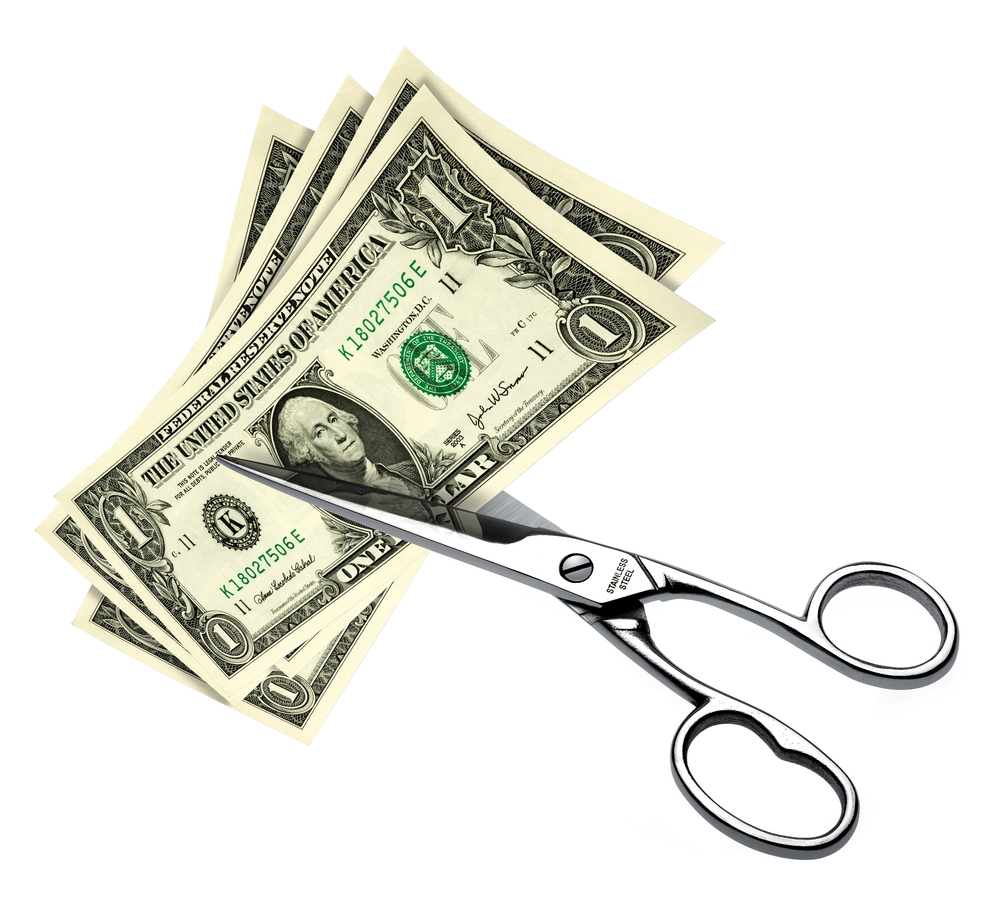
Profit (or loss) also known as net income (or net loss) are commonly referred to as the bottom line of a company because this figure sits at the bottom of the Profit and Loss statement. Net profit occurs when there is a surplus (or positive amount leftover) after all the expenses of running the business have been deducted from the revenue billed to customers. A loss (or negative profit) can of course incur if expenses are greater than revenue.
Cash flow is another beast entirely.
Positive cash flow occurs when the net amount of cash that flows in and out of a business during a period of time is greater than zero. In a nutshell, it means that the bank account of the business went up during the period because the company’s liquid assets are increasing. And for those of you following along with the Penny and Ernest metaphor, it means that the amount Ernest collected and put into the bank account, exceeded the amount that Penny spent.
KEY POINTS:
- It is possible for a company to have positive cash flow while reporting a loss on the Profit and Loss
- If a company has positive cash flow it means that it’s liquid assets increased over that period of time
- It is entirely possible for a company to post a loss on its Profit and Loss but still have positive cash flow because it received enough cash from borrowing and investing activities to offset the loss for accounting purposes
ANALYSIS:
Net profit or loss from the Profit and Loss statement is merely the starting point for calculating cash flow. Most businesses use something called “accrual accounting”, which means that profit includes revenue and expenses that may be collected or spent at some future point in time and some non-cash amounts. And if these items haven’t (or won’t) hit the bank account, they aren’t relevant to cash flow.
Since the Profit and Loss contains stuff that hasn’t happened yet (or is not relevant to cash), we cannot rely on it solely to make good decisions for the business. We must remove or adjust everything that hasn’t happened yet or is not relevant to cash, in order to get back to a number that represents pure cash flow. Said another way, we are looking to isolate the amount that Penny and Ernest have each run during the period.
To do this in practice, we need to look at the inter-relationship between the Profit & Loss statement and the Balance Sheet. This holistic perspective will give us a true picture of cash flow.
EXAMPLE:
For example, if we were to start from a position where the expenses of a business exceeded revenue (i.e. a net loss or negative income), the most likely result would also be negative cash flow. It is always more difficult to achieve positive cash flow when the business starts from the position of operating at a loss.
However, it is entirely possible to start with a net loss and simultaneously achieve net positive cash flow, but the following scenarios (which are not an exhaustive list) would have to happen in order for that to be feasible:
- The company could receive an influx of cash from either borrowings (i.e. bank debt) or the injection of further equity via investors.
- If the company has a net loss and also a large amount of depreciation expense recorded, the add-back of the depreciation expense (which is a non-cash item since no money leaves the business when depreciation is deducted for tax purposes) could push the company into positive cash flow territory.
- The sale of an asset, or just the reduction in total fixed assets over the period due to depreciation, could also kick up enough cash to help the company record positive cash flow under certain scenarios.
- The collection of receivables (or other money owed) that were posted in a prior accounting period but were collected and put into the bank in the current period is another simple way to push a company into a cash flow positive zone.
- Expenses are recorded on the Profit and Loss when they are incurred, not when they are paid. If a company posts a net loss due to a large amount of accrued expenses (where they were deducted in computing the loss but are not due to be paid until a subsequent financial period), it is entirely possible that the adjustment for these expenses might enable a company to maintain positive net cash flow, despite recording a net loss for tax purposes.
11 Feb 2015
Is Shark Tank Bad for Small Business?
If you’ve ever watched reality TV (and don’t say you haven’t because we all know it’s too easy to get sucked in by the drama and controversy), you may have noticed a specific formula…
First you find a cause – dating, small business, cooking or home improvement. Next, you add a few unassuming characters – some very relatable but also few who are downright crazy, nasty or delusional. And last but not least, you add just enough controversy, intrigue, shock and cutting remarks to keep the masses coming back for more each night.
In the end, are any of these contestants (or their small businesses in the case of Shark Tank) really any better off? Probably not, but what you have done is create some compelling TV and sold a bucket load of ads to big brands like iSelect, Swisee, Safeway, NAB and Mitre 10.
The other night, I watched Channel Ten’s latest reality TV import, Shark Tank. The premise is pretty straightforward.
A few naive and nervous and numerically challenged small business owners lined up to pitch to a panel of cool, critical and cashed-up potential investors.
Some ideas got funded for relatively small amounts. Most ideas (and their creators) got ripped to shreds by the panel.
So, the show is essentially Survivor, The Apprentice and The Bachelor all rolled into one with Australian small business contestants, and a catchy brand that has the ominous word “shark” in it.
How could that possibly fail?
As I watched, I wondered, ‘Are any of these small businesses likely to breakeven or become profitable and cash flow positive?’
And, perhaps not suprisingly, the answer is “not likely”.
Why is that? Because some of the ideas were pretty interesting. The cricket cooler, the motorized skate board and the hamdog may actually have global potential, but to be viable in the long term, the owners really need to do their homework first and know their numbers.
Case in point – not one of the small business owners who pitched had done market research with their product (or prototype) and could quantify the size of their market. Without that vital information, how can they possibly estimate topline revenue, market penetration or the value of their business with any precision or clarity?
And without those last three things, it’s impossible to give a meaningful pitch or ask for the “right amount” of capital. I’m sure you will agree, other than the guy who thought his hairbrained rental resume idea was worth $2.5million, most of the entrepreneurs vastly underestimated the amount of working capital that they needed.
Several contestants floundered when they got asked the big questions about breakeven, margins and cash flow. Yes, the dreaded cash flow question pretty much stumped everyone.
Most were asking for arbitrary sums of money to commercialise their inventions without regard for how much it might really take to get their brand out there and win their first major customers. One pair even thought it was clever to ask the investors to chip in $150,000 so they [the founders] could leave their secure day jobs and start working in the business full time. Crazy right? If you the owner don’t have skin in the game or work in the business full time, chances are you should still be writing your business plan, not pitching it on national TV in front of 5 sharks and a million viewers.
The cricket cooler duo were the most polished in terms of delivery and presentation. They recognized that patents and intellectual property were vital to their valuation and attractiveness to the sharks, but drastically underestimated the value of locking things down in India – the number one cricket market in the world. And the sophisticated sharks knew that Australia is just a mere drop in the bucket, compared to the potential in a market like India.
Unlike the really trashy stuff – Bachelor, Idol, or Real Housewives of Melbourne – the show didn’t make me feel icky or shocked while watching the sharks tear the flesh off the bones and gnaw away at the contestant’s dreams. I sort of expected that would be the main draw card and the whole premise of the show. Why call the show shark tank if you don’t intend to set up a blood bath and feeding frenzy?
But as an entrepreneur, I did feel genuinely remorseful for each of the contestants. The small businesses who got funded gave up decent chunks of equity for relatively small injections of capital – which may or may not be enough to get them to market and earn their first customers. And the ones who didn’t walked away without any constructive advice or tangible instructions on how to go away and get their idea investor-ready.
We live in a world with unlimited distractions, challenges, emergencies and interruptions – it’s a miracle any of us stay focused, sane and on track towards what we want (business improvement).
There are always going to be multiple tasks and priorities competing for your time – marketing campaigns to design, team members to manage, customers to respond to, business opportunities to explore, personal commitments etc. However, when you try to tackle too many things at the same time, nothing gets done. In the end, success and business improvement come down to focus.
In a world where there never seems to be enough time to get everything done, how can you avoid overwhelm, stay on track and get the things that are most important to you done? After all, it has been said there is always enough time in the day to do everything that is WORTH doing.
Here’s a list of questions that I have compiled over the years and shared with my clients and friends. They have helped me to put every challenge, “emergency” and distraction into perspective so that I can choose to focus my energy on what I really want and move forward toward my goals and business improvement each day. I hope some of these will also resonate with you…
1. Has Anyone Died? If not, relax, take a deep breath and know that as bad as things seem right now, “this too shall pass”. I learned this lesson the hard way when I was twenty four years old and had to come to grips with the terrible news that my mother had been murdered. As horrific and paralysing as this event was in my life, I eventually began to rebuild and discover strength that I never knew I had. And I learned a very important lesson – as long as no one has died, the situation really isn’t that grave, and there is always a solution or upside to every challenge you face.
2. Are You Trying to Eat an Elephant in One Sitting? Breaking things into bite-sized chunks makes the world of difference. Having broad high level business improvement goals are good but oftentimes it is easy to get overwhelmed by the amount of work that has to be done. That’s why having an actionable plan is essential – a step by step plan to help you move forward every day and get from where you are to where you want to be. After all, a journey of 1000 miles begins with one single step.
3. Are You In A Bad Neighbourhood? If you are in the ghetto emotionally, you need to change your physiology immediately. That means get up and get moving – put on your favourite song, connect with someone face to face or do a hobby/sport that makes you smile. Whatever it takes, do it NOW.
4. Are You Grateful For What You Already Have? It is impossible to attract more of what you want into your life if you are feeling ungrateful about what you already have. It has been said that the whole is more than the sum of its parts. In many ways gratitude is a bit like that – it’s not what you say, the mere words that count, but sum of the words and the heartfelt emotion that you put behind them.
5. Are You focused on What You Want or Don’t Want? Whether you realise it or not, you are visualising things all the time – visualising either what you want or don’t want. If you are relentlessly focused on the negative outcome and are riddled with fear, your thoughts will impact your reality and push what you want further away.
6. Does it Have To Be Perfect? Perfection can immobilize you and hamper business improvement – prevent you from making a decision, starting a project or signing off on a piece of important work. Truth is, most tasks on your list don’t have to be 100% perfect, you just need to pull the trigger and sign off on them today. The other way that this problem can show up is when you deceive yourself by believing that no-one else can do the job (even simple routine tasks) to your exacting standard, so you must do it ALL yourself. Try the 80/20 rule – delegate what you do not have to do yourself and give yourself permission to be human!
7. Are You Still Holding On To The Past – Have you ever caught yourself saying “last time I tried that, it didn’t work”? Or have you ever avoided doing something that you know you need to do but were afraid because it didn’t work last time? Even though it’s a good idea to stop doing what clearly isn’t working, it’s also important to remember that the past does not necessarily equal the future. If you catch yourself using reasons from the past to justify why you are not moving ahead today, you owe it to yourself to recognize this for what it is – self sabotage – and take action.
8. Are You Listening To Your Own Inner Voice? – The quickest way to guarantee failure and unhappiness is to worry too much about what other people might think. Deep down you know what is right for you in every circumstance. Sometimes it is tempting to suppress or ignore your gut instincts but there is freedom and relief in choosing to listen and to stand behind the decisions that you know are right for you. If you choose to please others, there will always be at least one other person who is unhappy with your choices, plus yourself.
9. Are You Avoiding Your Fears? – Ironically, everything you want is on the other side of your fear. Sometimes we are coaxed to the edge of our fears and pushed off, yet other times we willingly wander there, oblivious to what lies ahead. Either is good – for at the moment you feel your feet leave the safety of the cliff top – you will always find your wings and fly.
10. Are You Afraid of Making a Mistake? – It is only when we are stretched that we discover new things about ourselves. Often it is adversity and mistakes that allow us to become aware of and uncover our own innate talents. If mistakes were fatal, we wouldn’t enjoy most of the modern conveniences that we take for granted every day. Taking a risk and making a mistake is far better than doing nothing. In the brilliant words of Theodore Roosevelt “the best thing you can do is the right thing, the next best thing is the wrong thing, and the worst thing you can do is nothing”.
11. Do You Have Reasons or Results? – In life you either have results or you have reasons, but it is impossible to have both. If you don’t like the results you have produced, you will do one of two things (1) find a reason or excuse to explain why or (2) change your behaviour to produce a different result. Looking for justification as to why things have not worked out is a pointless exercise. When we look at causes, rather than reasons, things are very different. There is no failure, only results. Essentially, it means never having a reason or excuse again.
12. Are You Unrealistic? In order to succeed and achieve your goal of business improvement, you have to be at least a little unrealistic. Being realistic, never led to any significant change, innovation or giant leap forward. Only unrealistic thinking will achieve a result that until now seemed impossible. In the ‘60s, U.S. President Kennedy seemed unrealistic when he announced to a very large audience that America would put a man on the moon in less than a decade. Prior to that statement, a lunar landing seemed impossible, or at the very least, something that was a long way off.
13. Have You Forgiven Yourself & Others? Perhaps we never really completely understand life until we face death. What if we all started off on our deathbeds? Would it make a difference? Would it change the way we choose to play the game? Would it take us to forgiveness sooner? On our deathbed, I doubt any of us would say ‘I wish I held onto more anger and resentment or took a bit longer to forgive.’ In fact, if you were to look out into the future and imagine the world and all of your relationships from a position where you knew with absolute certainty that they would be gone tomorrow, would you act differently today? Would you mourn the years that you kept yourself enslaved by bitterness, blame and indignation? Would you lament the loss of pleasure, love and peace that could have been yours if only you could have found a way to forgive sooner?
14. Are You Hiding Who You Really Are? – We all have scars, but they are not ‘terminal’ blemishes, evidence of your defects, or validation of your lack of worthiness. Richard Nixon once famously said “the finest steel goes through the hottest fire”. Life isn’t easy but that perhaps it was never designed to be! Amazing things can happen, character and strength often develop through the most challenging circumstances – whether the heat destroys you or sculpts you is entirely up to you.
15. Are You a Poor Communicator? – Anytime you have more than one person observing an event, the door is open for the possibility of misinterpretation and miscommunication based on differing maps of reality. Learning to recognise that we all have different maps (filters by which we see and process the world around us) allows us to see the world through another person’s eyes and therefore understand, relate and communicate with greater respect and results.
16. Are You Thinking Inside Your Box? – Our beliefs about what is true, right, real or possible are largely assembled in childhood through a process called conditioning. Essentially children learn what is ‘normal’ from the people around them. These beliefs about the world can have a massive impact on how your life turns out. Einstein referred to limiting beliefs as the “boundary conditions of our thinking” – they act as a box that we unconsciously put ourselves in from a very young age. What we consider possible is influenced by these rigid ideas. That is why it has often been said that the thinking that got you to where you are now will never get us to where you want to be.
17. Are You Running Away? – Sometimes a fresh start can do you a world of good, but the interesting thing about a fresh start is that it never stays fresh for very long. The irritating part of physical or geographical changes is that you stay the same – wherever you go, there you are. As time passes you are forced to realise that while there may be a new job, new boss, new partner, or a new view out the window of your kitchen – you are exactly the same! Now might be a great time to look at the changes that need to come from within.
18. Are You Over Thinking It? – Most of us make a ‘decision’ today, knowing that tomorrow we can change our mind, backtrack or simply do nothing. That isn’t a decision. Unless you take action immediately towards your goal, you haven’t really decided … you are merely thinking about it.
19. Are You Motivated? – No matter whether you have experienced awful things in life or not, there is an innate drive in all of us to seek meaning and purpose. If we understand our ‘why’ then we can deal with any ‘how’ that life brings our way. Even in the darkest of nights, we can all find a way to let the light of who we really are shine through, if we believe in our hearts that there is a grander purpose.
20. Are You Driving The Bus? – I am the only one who can attribute meaning to the events in my life and the same is true for you. Positive, negative or neutral – the choice is always yours. If you are not happy with the choices you have made so far in life the great news is that you can choose new meanings immediately that will drive you towards your bright and compelling future. It’s never too late to become the person you were meant to be!
21. Are You Your Own Worst Enemy? – In my own life, it has never been the load or the obstacles that broke me, but rather the manner in which I chose to carry them. Despite what happens or what others think/say, it’s the things we tell ourselves when no one else is listening, that have the biggest potential to harm and hold us back. Re-writing negative self-talk is the single biggest gift you can give yourself this year.
It’s very easy to get so caught up in the emotion of emergencies, distractions and thoughts that don’t serve you – you can easily lose sight of what is most important to your success, business improvement and well-being. These simple questions (and keeping your sense of humour) are vital to helping you to stay focused and moving towards your goals and success.
John Wannamaker may not be a household name but he opened the first department store in Philadelphia in the late 1800’s and is believed to be the inventor of the price tag and the seasonal sale. He was the first retailer to place a half-page newspaper ad, and also the first full-page ad five years later. He is widely considered to be one of the fore-fathers of advertising and credited with the famous phrase: “Half the money I spend on advertising is wasted; the trouble is, I don’t know which half.”
His words survive as one of the most frequently quoted clichés in marketing and advertising, even after radio, TV and now the internet, have replaced the dominance of print advertising.
Why with all we’ve accomplished in the last one hundred and twenty years, is this quote still relevant and significant to you (and to all marketers) today?
In fact how do you know you’re not throwing away 2/3 of your advertising budget? Or perhaps even as much as 3/4?
How can you be sure that your next campaign, sitting on your desk waiting for your approval, won’t be an abysmal failure – sucking your bank account dry and producing no measurable influx of qualified leads and sales?
Do you know with certainty which half of your advertising budget is wasted? Want if you needed to find out?
Right now, your audience is getting harder to reach in all the traditional media channels, and the rules of marketing have changed. Print newspaper readership, radio listeners and even TV viewers are down. Consumers have adapted to new technologies – the internet, iTunes, podcasts, downloads – and can now comfortably avoid unwanted advertising in many of these old channels.
Many of the old ways are being replaced by new ones. The internet, content marketing, video and social media have emerged as the new, dominant players. To succeed in this new realm of advertising, requires a shift in both mindset and strategy.
You used to be able to get away with talking at your prospects (or having one-way conversations), now you must respond to their comments (positive and negative) in real time.
Where five years ago you could simply focus on spending less to find more local prospects, now you must excel at “being found” in a sea of global competitors.
Thankfully, these new mediums bring with them two significant benefits – targeting and measurability. Finally, improving your odds of determining which half of your advertising budget is wasted, is not only possible, but refreshingly do-able. You simply have to know which tips and tools to use to maximize your return on investment (ROI).
Here are five practical tips for developing an effective measurement strategy for your online and offline marketing communications – (and for determining which half of your advertising budget is wasted):
1) Monitor all incoming leads
Where possible, place a unique phone number (or email address) in different media placements to gauge which ad creative, copy, design elements or physical placement garners the most qualified traffic and sales. Each unique number or email address can easily be re-routed to your primary incoming line or email, so you can streamline the process of receiving and replying to these valuable enquiries. To minimize confusion with your target audience, try to refrain from using too many different numbers at once.
For some brands, that are highly identifiable and use a memorable phone number, tracking may not be viable. As an alternative, try recording the inbound calls and use the insights to train your sales team. While it may cost more, the recorded conversations will provide significant insight into the interest level, FAQ’s, objections and pain/issues of your prospects.
2) Use Split Testing
When you see a banner, video, text or display ad online, it has been sent to your computer or mobile device from an ad server. In most cases, what this means is that the advertiser will have been given the opportunity to split test their ads – to change their online creative in real time to monitor impressions, clicks, engagement and conversions. Essentially some of the audience will see one version of the ad, while others may see different versions.
But split testing doesn’t just apply to online ads and websites. In fact it can be used effectively with any online or offline marketing piece to test different creative, copy, or calls to action. It allows your audience to tell you in tangible terms which messages they prefer and are inclined to respond to favourably.
3) Set Up Specific Landing Pages
Most small business owners will make the mistake of wasting a lot of money on ads to send traffic direct to their homepage. More often than not, 90% of this traffic will bounce off your website within seconds because the content they are interested in is either not featured prominently on the homepage or is just too hard to find. In order to maximize the engagement of your traffic and your ROI, you need to ensure that you are taking your leads to pages where the specific content and offer you are advertising is the ONLY information presented.
The easiest way to do this is to set up landing (or private) pages on your site with unique URLs for each offer. The landing page will give each user a more customized experience and it will allow you to set the stage for an inquiry, call to action or sale.
These landing pages are also extremely effective for allowing you to track and measure ROI from both online and offline ads – when a prospect converts, you can directly attribute that conversion to a specific marketing piece because the landing page URL is unique for each one. Where possible, remember to use a user-friendly URL (one that is short, relevant and easy to remember) to drive traffic from offline media – it will boost retention, recall and action by up to ten times.
4) Google Analytics
Google Analytics is an invaluable tool that can help you measure what is working and what isn’t on your website. However, just like the human brain, most site owners haven’t fully tapped into the full potential and power of it. In addition to telling you where your traffic is coming from and which search terms or links were used to find you, Google Analytics also measures where users click most on a given page, how long they spent on your site and where they go when they navigate away from your page. Google analytics can provide you with enough data to isolate and eliminate marketing that’s not generating profitable growth.
Research indicates that the average conversion rate for a website is between 2.2 – 4%. What this means is that 96-97.8% of the visitors that came to your site today, left without taking any action. They key to minimizing the leakage and maximizing the percentage that remember your message and take action lies in analysing the data that Google can provide on your website traffic and trends. It doesn’t make sense to spend more money on marketing if a large percentage of your audience is choosing not to take action.
5) Stop Chasing Clicks and Eyeballs
A click (or eyeball viewing your offline ad) means nothing to your business. It earns no revenue and creates no brand equity. Your advertising has to have a tangible end goal – and it shouldn’t be to reach the most eyeballs or generate lots of clicks. To have a successful business, you need people to discover how you can cure their pain, seek more information, join your list, or purchase your product/service. Success lies not in how many people know what you do but rather in how many you are able to connect with and inspire to say “yes” to your product/service.
 If you’re in business, one of the most important questions that you must be asking yourself is “what is the best way to grow your business?” How can you take what you have, expand on it but keep your costs as low as possible?
If you’re in business, one of the most important questions that you must be asking yourself is “what is the best way to grow your business?” How can you take what you have, expand on it but keep your costs as low as possible?
Fortunately, history has given us plenty of good examples of how NOT to do this. Perhaps the best of these happened in 2001 – when thousands of companies went under in the dot com bubble.
But how did so many go so far wrong?
In those days, start-ups (with little or no income) and existing companies (with dreams of expanding their business online) were renting the biggest and best offices. They were signing huge print advertising contracts, paying ridiculous sums for banner ads and taking enormous salaries.
When sales were lower than expected and the cash to keep paying all those expenses dried up, these businesses had no way of easily adjusting their monthly expenditures because they were primarily FIXED, not variable. Their only option was to declare themselves bankrupt and close down.
Compare this situation with Amazon.com which started in a suburban garage with old doors on sawhorses for desks. By keeping fixed costs down, they were able to stay in business long enough to start generating a profit. They are now a huge company (with real offices) making huge profits.
So how does all of this apply to your company?
No matter how big your current business is, the aim is to grow your business while keeping your fixed costs as low as possible as a percentage of sales. And there are many practical ways to do this.
Begin by creating a simple excel spreadsheet of your current revenue and expenses each month. Ensure that you have correctly separated the fixed and variable costs of doing business. Roughly speaking, the breakdown should look something like this:
Revenue
– Cost of Sales (includes cost of goods and wages for subcontractors)
= Gross Profit
– Fixed costs (includes rent, wages, marketing, telephone and utilities etc.)
= Net Profit
Based on your current financial results, set your monthly revenue targets for the next 12 months and estimate the cost of goods sold. For example, if you currently generate $20,000/month in sales with a 60% gross profit margin, you might like to grow your business by 25%? Therefore, you would use a projected sales target of $25,000 each month with Cost of goods sold at around $10,000 as a starting point. This would leave you with a gross profit each month of $15,000. If your sales fluctuate each month due to seasonal variations, manually adjust your forecast to reflect these ups and downs so that you will have a more realistic picture of your financial performance.
Now here is where most business owners will go wrong…
Most business owners will make the mistake of assuming that fixed costs are fixed – the owner will just blindly start to place the existing amounts for rent, marketing, wages, telephone etc. into the financial projections. Fixed costs are referred to as fixed because they are fixed at a point in time. This does not mean however, that they are fixed forever and cannot be altered. In fact, when you are preparing a business plan and financial projections to grow your business, you should consider almost every aspect of your business as “up for debate and re-adjustment”.
That is one reason why you need a decent business plans – you can use it to re-evaluate and plan for the future so that you can improve and grow your business. Without a concrete plan, in all likelihood, you will continue to get the exact same results that you got last year.
Where you will get the most value in this exercise is by going back over each cost (fixed or variable) to identify opportunities to improve your gross and net profit margins. Cutting costs may be possible and advisable in some areas of your business. However, cutting costs [in isolation] is not usually an effective strategy to grow a business. In order to grow and improve your bottom line, you will need to ask yourself the question – “how can I grow my business without expanding costs”?
Here are some effective ways to do just that:
1. Think of ways to partner with others to expand your reach and sales without actually having to open another location or hire more full time employees. You may already have underutilized capacity to increase your sales right now.
2. Introduce products or services that complement the ones that you currently have and contribute more to the bottom line of your business.
3. Re-negotiate the terms or prices you have with your suppliers to increase your gross profit margin.
4. Selling online is a very cost effective way to increase your reach without increasing fixed costs.
5. If you manufacture goods, you could identify ways to increase production simply by tidying up, rearranging the layout of machines and planning more cleverly (to reduce work in progress and downtime). Often mistakes and rework can be costly to your business and surprisingly, they can be prevented by taking time during the business planning process to brainstorm solutions. Making better use of time is another fantastic way to increase production with minimal impact on fixed costs.
Surprisingly, 95% of business owners never take the time to create a business plan and forecast of revenues and expenses. Of the 5% that do, only a small portion refer back and measure their progress against their key performance targets. That is the number one reason why so many businesses either don’t make much profit, or worse, go under, each year.
A business plan doesn’t have to be 50 pages in length and take 200 hours to complete. It just has to be realistic and useful. To do this properly, follow my basic outline for projected revenues and expenses above. It should only take 48 hours of your time. 48 hours, in exchange for more sales, more profit and peace of mind, is a small price to pay.















